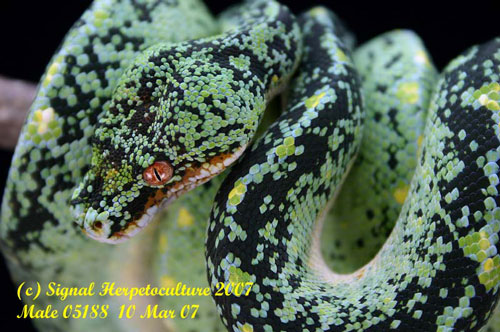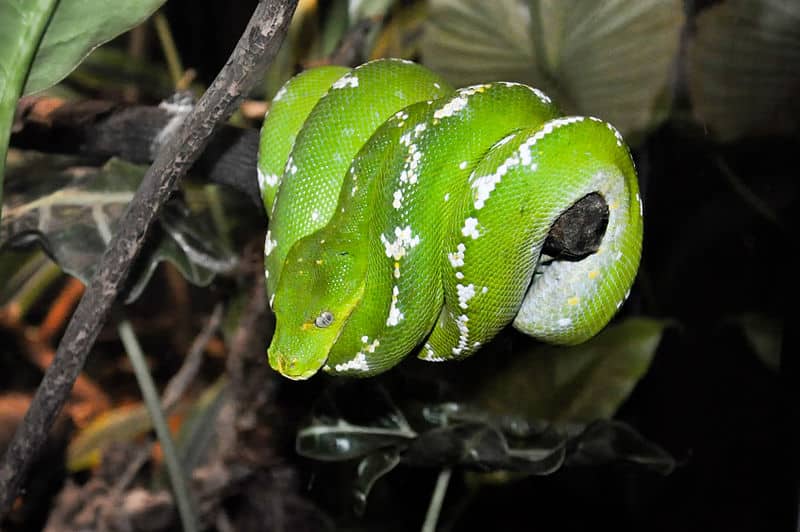Care sheet for the green tree python (Morelia viridis).
Updated February 1, 2023
Green Tree Python (Morelia viridis)
Green tree pythons are definitely one of the reptile hobby’s rising stars. As their common name suggests, these snakes spend a great deal of time in trees. But they are not always green. They come in a wide array of colors found in both wild and captive-bred designer forms. Only one recessive morph, the albino, currently exists.
Juvenile green tree pythons are typically yellow, red or dark brown-black. As they mature, their color changes to the bright green many adults display. Some individuals keep their bright-yellow juvenile colors, and some turn straight to blue. Each color is unique and stunning in its own way. Watching the color change is one of the most exciting things about owning these beautiful snakes.
Green Tree Python Availability
Captive-bred green tree pythons are becoming increasingly available as more people have success breeding them. Many websites and forums dedicated to the species provide quality captive-bred specimens. It is best to find reputable breeders who can help you with selecting the right snake and to help answer your questions.
Inquire about the origin of a prospective pet. Many green tree pythons available today originate on Indonesian farms. These specimens may appear healthy at first, but they can harbor parasites that take their toll over time. A breeder near you should have healthy, well-cared-for animals that have not undergone the stress of being shipped halfway around the world.

All photos © Signal Herpetoculture.
Green Tree Python Size
Hatchling green tree pythons usually measure between 8 and 10 inches long. Adults average between 4 and 6 feet, with males on the lower end of this scale and females on the upper end. Males are typically more slender than females as well.
Green Tree Python Life Span
Most green tree pythons can be expected to live into their mid-teens with good care. A few have even made it into their mid-20s. This is a more fragile and advanced species, but with prioritized reptile health and wellness along with using the proper snake supplies will ensure a happy, healthy life in captivity.
Green Tree Python Caging
House green tree pythons in cages providing easy viewing so you can really enjoy their beauty. Many front-opening plastic and glass reptile terrariums can be outfitted to accommodate the needs of these arboreal snakes. You may need to cover a portion of the screen top to help maintain the proper humidity level.
Juveniles can be shy, so it’s best to start them off in smaller enclosures measuring 1′ x1’x 1′. Adult green tree pythons make full use of the larger sizes, such as 2’x’2’x’2 enclosures or 3’x’2’x’2 enclosures.
One of the biggest misconceptions about green tree pythons and arboreal snakes is that their enclosures should be very tall. With tall cages these snakes typically select the highest perch and their water bowls are usually located on the cage floor. Sometimes, the python never comes down to drink and eventually suffers from dehydration. When green tree pythons become active, they crawl horizontally through the trees — not up and down the trunks of trees. Horizontal space is far more valuable than vertical space. A good general rule is that the snake should be able to comfortably reach the bottom of the enclosure from the highest perch. You can be creative with snake habitat products. Even though these animals spend most of their lives in trees, they make good use of horizontal space. When active, they spend their time crawling through tree branches and occasionally move from one level to another.
The enclosure should have sturdy resting branches or perches for the snake. A green tree python spends its days coiled on a perch with its head resting in the center of its coils. At night snakes become active and explore their surroundings. Multiple climbing branches of varying sizes help to provide variety and a more enriching environment. Be sure perches are securely fastened; otherwise a snake could be injured. Adding a few live plants will not only make the tank look nice and provide cover but also will help to create humid microclimates within the enclosure.
Green Tree Python Snake Lighting and Temperature
Green tree pythons do not require full-spectrum lighting to metabolize calcium, but a quality full-spectrum lamp brings out all the vibrant colors in your pet. Because the day length in their natural habitat is nearly the same year round, you can provide 12 hours of light each day using reptile timers.
Tropical rain forests are the green tree python’s native habitat, so captive snakes need a warm and humid environment. Throughout their natural range they seldom experience temperatures below 70 degrees Fahrenheit. Offer a range of temperatures within the enclosure so the animal can select its ideal temperature. You can use reptile thermometers to monitor your habitat temps. During the day provide an area where the animals can bask in a temperature between 86 and 88 degrees, and a retreat around 78 to 80 degrees. Allow a retreat, but not a place to hide. The retreat should be an area with lower ambient temperatures. Occasionally shy snakes, if given a lot of cover (hide areas), will remain hidden and not thermoregulate properly — even to the point of becoming ill. At night the temperature throughout the enclosure can drop a few degrees, but it should not go below 70 to 72 degrees.
The humidity range for green tree pythons should be 40 to 70 percent. It can be higher for short periods – such as after a misting – but should be thoroughly dry between mistings. You can use a the Exo Terra Reptile Mister and humidity hygrometers to monitor humidity in the habitat. The environment should not be constantly wet as it can cause the snake to develop dermal infections.
Green Tree Python Snake Substrate
Many substrates are suitable for green tree python enclosures. Newspaper is easy to clean, but it’s not aesthetically pleasing for some people. Many snake keepers use various mulches or coconut-husk products because they are pleasing to the eye and also help provide the humidity to keep these animals healthy. Dampened mulch or coconut husk can usually hold moisture for several days. Spot-clean such substrates as necessary, and completely clean the enclosure every few months to keep bacteria or mold in check.
What Do Green Tree Python Eat?
Wild green tree pythons are arboreal predators, so captive specimens thrive on a diet of appropriately sized rodents. Feed juveniles a small mouse every five to seven days. Older juveniles and young adults can be fed a hopper or medium mouse every seven to 10 days. Adults can be given a meal of one or two adult mice, or a small rat every 10 to 14 days. Be careful not to overfeed your green tree python. These naturally slender snakes have a sedentary lifestyle. They can easily become overweight, which can lead to health problems.
Green Tree Python Water
Wild green tree pythons experience rain showers nearly every day in their rain forest habitat. You can simulate these rain showers with spray bottles or misting systems. A gentle spray throughout the enclosure each day helps to encourage the animal to be active and seek out moisture. Be sure the enclosure can dry between sprayings to keep down any bacteria that may develop in a constantly warm and moist environment.
Often a green tree python drinks water droplets from the sides of the cage and its furnishings. It is wise to keep a bowl of clean, fresh water in the enclosure, too. Some snakes drink more readily from an elevated water bowl located near their perch.
Green Tree Python Handling and Temperament
Rico could write an entire article on green tree python handling and temperment. Wait; he already did. If you’re a lifelong subscriber to REPTILES magazine, you can find the article in the April 2006 issue. If you’re not, here’s a quick overview.
Green tree pythons have gotten a bad rap over the years. They have a reputation of being aggressive, but for the most part this is untrue. Their attitude can be a reflection of how they’ve been treated. If they are grabbed, physically restrained and treated roughly, they will become defensive and appear aggressive when approached.
The best thing to do when you want to handle a green tree python is to remove the animal from its enclosure while it is still resting on its perch. Remain calm and deliberate in your movements regardless of how the animal reacts. It is best to approach the snake from below with your free hand. This is far less threatening than approaching from above. Gently support the snake’s lower coils, and allow it to begin leaving the perch voluntarily. Raise the coils with your hand as the python begins to leave the perch. Never pull the snake from its perch. Instead, offer it another secure perching location. With a gentle and calm approach most green tree pythons will tolerate handling for short periods.
Rico Walder and Trooper Walsh are the source for Green Tree Pythons and Green Tree Python information. Please visit Signal Herpetoculture at SignalHerp.com, and the Chondro Coalition at ChondroCoalition.com.


